+ Open data
Open data
- Basic information
Basic information
| Entry | Database: EMDB / ID: EMD-20210 | ||||||||||||
|---|---|---|---|---|---|---|---|---|---|---|---|---|---|
| Title | Synthetic beta-carboxysome shell (T=4) | ||||||||||||
 Map data Map data | sharpened and cropped map used for figures. | ||||||||||||
 Sample Sample |
| ||||||||||||
| Biological species |  Halothece sp. PCC 7418 (bacteria) Halothece sp. PCC 7418 (bacteria) | ||||||||||||
| Method | single particle reconstruction / cryo EM / Resolution: 3.7 Å | ||||||||||||
 Authors Authors | Sutter M / Laughlin TG / Sloan NB / Serwas D / Davies KM / Kerfeld CA | ||||||||||||
| Funding support |  United States, 3 items United States, 3 items
| ||||||||||||
 Citation Citation |  Journal: Plant Physiol / Year: 2019 Journal: Plant Physiol / Year: 2019Title: Structure of a Synthetic -Carboxysome Shell. Authors: Markus Sutter / Thomas G Laughlin / Nancy B Sloan / Daniel Serwas / Karen M Davies / Cheryl A Kerfeld /  Abstract: Carboxysomes are capsid-like, CO-fixing organelles that are present in all cyanobacteria and some chemoautotrophs and that substantially contribute to global primary production. They are composed of ...Carboxysomes are capsid-like, CO-fixing organelles that are present in all cyanobacteria and some chemoautotrophs and that substantially contribute to global primary production. They are composed of a selectively permeable protein shell that encapsulates Rubisco, the principal CO-fixing enzyme, and carbonic anhydrase. As the centerpiece of the carbon-concentrating mechanism, by packaging enzymes that collectively enhance catalysis, the carboxysome shell enables the generation of a locally elevated concentration of substrate CO and the prevention of CO escape. A functional carboxysome consisting of an intact shell and cargo is essential for cyanobacterial growth under ambient CO concentrations. Using cryo-electron microscopy, we have determined the structure of a recombinantly produced simplified β-carboxysome shell. The structure reveals the sidedness and the specific interactions between the carboxysome shell proteins. The model provides insight into the structural basis of selective permeability of the carboxysome shell and can be used to design modifications to investigate the mechanisms of cargo encapsulation and other physiochemical properties such as permeability. Notably, the permeability properties are of great interest for modeling and evaluating this carbon-concentrating mechanism in metabolic engineering. Moreover, we find striking similarity between the carboxysome shell and the structurally characterized, evolutionarily distant metabolosome shell, implying universal architectural principles for bacterial microcompartment shells. | ||||||||||||
| History |
|
- Structure visualization
Structure visualization
| Movie |
 Movie viewer Movie viewer |
|---|---|
| Structure viewer | EM map:  SurfView SurfView Molmil Molmil Jmol/JSmol Jmol/JSmol |
| Supplemental images |
- Downloads & links
Downloads & links
-EMDB archive
| Map data |  emd_20210.map.gz emd_20210.map.gz | 23.3 MB |  EMDB map data format EMDB map data format | |
|---|---|---|---|---|
| Header (meta data) |  emd-20210-v30.xml emd-20210-v30.xml emd-20210.xml emd-20210.xml | 16.6 KB 16.6 KB | Display Display |  EMDB header EMDB header |
| FSC (resolution estimation) |  emd_20210_fsc.xml emd_20210_fsc.xml | 17.2 KB | Display |  FSC data file FSC data file |
| Images |  emd_20210.png emd_20210.png | 95.5 KB | ||
| Masks |  emd_20210_msk_1.map emd_20210_msk_1.map | 432.5 MB |  Mask map Mask map | |
| Others |  emd_20210_half_map_1.map.gz emd_20210_half_map_1.map.gz emd_20210_half_map_2.map.gz emd_20210_half_map_2.map.gz | 346.1 MB 346.6 MB | ||
| Archive directory |  http://ftp.pdbj.org/pub/emdb/structures/EMD-20210 http://ftp.pdbj.org/pub/emdb/structures/EMD-20210 ftp://ftp.pdbj.org/pub/emdb/structures/EMD-20210 ftp://ftp.pdbj.org/pub/emdb/structures/EMD-20210 | HTTPS FTP |
-Validation report
| Summary document |  emd_20210_validation.pdf.gz emd_20210_validation.pdf.gz | 77.8 KB | Display |  EMDB validaton report EMDB validaton report |
|---|---|---|---|---|
| Full document |  emd_20210_full_validation.pdf.gz emd_20210_full_validation.pdf.gz | 76.9 KB | Display | |
| Data in XML |  emd_20210_validation.xml.gz emd_20210_validation.xml.gz | 494 B | Display | |
| Arichive directory |  https://ftp.pdbj.org/pub/emdb/validation_reports/EMD-20210 https://ftp.pdbj.org/pub/emdb/validation_reports/EMD-20210 ftp://ftp.pdbj.org/pub/emdb/validation_reports/EMD-20210 ftp://ftp.pdbj.org/pub/emdb/validation_reports/EMD-20210 | HTTPS FTP |
-Related structure data
| Related structure data |  6owfC  6owgC C: citing same article ( |
|---|---|
| Similar structure data | |
| EM raw data |  EMPIAR-10275 (Title: Structure of a synthetic beta-carboxysome shell / Data size: 423.5 EMPIAR-10275 (Title: Structure of a synthetic beta-carboxysome shell / Data size: 423.5 Data #1: Unaligned multiframe micrographs for synthetic carboxysome shells [micrographs - multiframe]) |
- Links
Links
| EMDB pages |  EMDB (EBI/PDBe) / EMDB (EBI/PDBe) /  EMDataResource EMDataResource |
|---|---|
| Related items in Molecule of the Month |
- Map
Map
| File |  Download / File: emd_20210.map.gz / Format: CCP4 / Size: 27.9 MB / Type: IMAGE STORED AS FLOATING POINT NUMBER (4 BYTES) Download / File: emd_20210.map.gz / Format: CCP4 / Size: 27.9 MB / Type: IMAGE STORED AS FLOATING POINT NUMBER (4 BYTES) | ||||||||||||||||||||||||||||||||||||||||||||||||||||||||||||||||||||
|---|---|---|---|---|---|---|---|---|---|---|---|---|---|---|---|---|---|---|---|---|---|---|---|---|---|---|---|---|---|---|---|---|---|---|---|---|---|---|---|---|---|---|---|---|---|---|---|---|---|---|---|---|---|---|---|---|---|---|---|---|---|---|---|---|---|---|---|---|---|
| Annotation | sharpened and cropped map used for figures. | ||||||||||||||||||||||||||||||||||||||||||||||||||||||||||||||||||||
| Projections & slices | Image control
Images are generated by Spider. generated in cubic-lattice coordinate | ||||||||||||||||||||||||||||||||||||||||||||||||||||||||||||||||||||
| Voxel size | X=Y=Z: 0.8908 Å | ||||||||||||||||||||||||||||||||||||||||||||||||||||||||||||||||||||
| Density |
| ||||||||||||||||||||||||||||||||||||||||||||||||||||||||||||||||||||
| Symmetry | Space group: 1 | ||||||||||||||||||||||||||||||||||||||||||||||||||||||||||||||||||||
| Details | EMDB XML:
CCP4 map header:
| ||||||||||||||||||||||||||||||||||||||||||||||||||||||||||||||||||||
-Supplemental data
-Mask #1
| File |  emd_20210_msk_1.map emd_20210_msk_1.map | ||||||||||||
|---|---|---|---|---|---|---|---|---|---|---|---|---|---|
| Projections & Slices |
| ||||||||||||
| Density Histograms |
-Half map: shell (T=4)
| File | emd_20210_half_map_1.map | ||||||||||||
|---|---|---|---|---|---|---|---|---|---|---|---|---|---|
| Annotation | shell (T=4) | ||||||||||||
| Projections & Slices |
| ||||||||||||
| Density Histograms |
-Half map: shell (T=4)
| File | emd_20210_half_map_2.map | ||||||||||||
|---|---|---|---|---|---|---|---|---|---|---|---|---|---|
| Annotation | shell (T=4) | ||||||||||||
| Projections & Slices |
| ||||||||||||
| Density Histograms |
- Sample components
Sample components
-Entire : Synthetic beta-carboxysome shell (prolate symmetry expansion focu...
| Entire | Name: Synthetic beta-carboxysome shell (prolate symmetry expansion focused refinement) |
|---|---|
| Components |
|
-Supramolecule #1: Synthetic beta-carboxysome shell (prolate symmetry expansion focu...
| Supramolecule | Name: Synthetic beta-carboxysome shell (prolate symmetry expansion focused refinement) type: complex / ID: 1 / Parent: 0 / Details: bacterial microcompartment |
|---|---|
| Source (natural) | Organism:  Halothece sp. PCC 7418 (bacteria) Halothece sp. PCC 7418 (bacteria) |
| Recombinant expression | Organism:  |
-Experimental details
-Structure determination
| Method | cryo EM |
|---|---|
 Processing Processing | single particle reconstruction |
| Aggregation state | particle |
- Sample preparation
Sample preparation
| Concentration | 0.6 mg/mL |
|---|---|
| Buffer | pH: 8 |
| Vitrification | Cryogen name: ETHANE / Chamber humidity: 100 % / Chamber temperature: 277 K / Instrument: FEI VITROBOT MARK IV / Details: blot for 6 seconds before plunging. |
- Electron microscopy
Electron microscopy
| Microscope | FEI TITAN KRIOS |
|---|---|
| Specialist optics | Energy filter - Name: GIF Quantum LS / Energy filter - Slit width: 25 eV |
| Image recording | Film or detector model: GATAN K2 SUMMIT (4k x 4k) / Detector mode: SUPER-RESOLUTION / Digitization - Frames/image: 1-25 / Number grids imaged: 1 / Number real images: 1343 / Average exposure time: 6.0 sec. / Average electron dose: 50.0 e/Å2 |
| Electron beam | Acceleration voltage: 300 kV / Electron source:  FIELD EMISSION GUN FIELD EMISSION GUN |
| Electron optics | Calibrated magnification: 56000 / Illumination mode: FLOOD BEAM / Imaging mode: BRIGHT FIELD / Cs: 2.7 mm / Nominal defocus max: 2.0 µm / Nominal defocus min: 0.5 µm |
| Sample stage | Specimen holder model: FEI TITAN KRIOS AUTOGRID HOLDER / Cooling holder cryogen: NITROGEN |
| Experimental equipment |  Model: Titan Krios / Image courtesy: FEI Company |
 Movie
Movie Controller
Controller




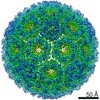



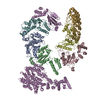


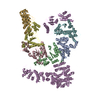


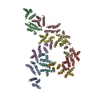
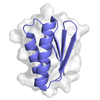
 X (Sec.)
X (Sec.) Y (Row.)
Y (Row.) Z (Col.)
Z (Col.)














































